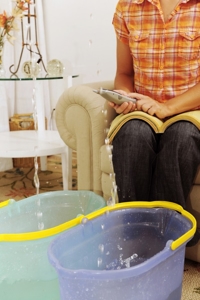
Even the smallest roof damage can allow moisture to seep into your home, resulting in the development of mold. Not only do you have to have the roof issue repaired, but now you need to address any damage the leak has caused to the interior of the home. The first step for dealing with roof leaks and mold is to determine the cause of the leak and then have it repaired.
Causes of Roof Leaks
The causes of roof leaks vary, but the most common that can lead to slow water damage include:
- Broken or missing shingles
- Improperly installed or damaged flashing
- Incorrect roofing materials
- Ice dams
Shingles become damaged or even get blown away in strong storms. Sometimes a damaged or missing shingle is obvious, especially if the roof shingle(s) are now laying in the yard after last night's storm. However, it's not always easy to see if a shingle is damaged and the only indication of its poor condition is after water damage already has occurred.
Improperly installed or damaged flashing, the metal installed around the chimney, dormer windows, skylights and any vent pipe, can allow water and moisture into the home, causing mold to develop.
Certain roofing materials are designed specifically certain types of roofs. For example, a roof with a pitch (steepness) that's less than 3:12 requires materials designed specifically for a flat roof. If your roof was not constructed with the correct and proper fitting materials, leaks can happen.
The University of Minnesota Extension office defines an ice dam as "a ridge of ice that forms at the edge of a roof and prevents melting snow (water) from draining off the roof. The water that backs up behind the dam can leak into a home and cause damage to walls, ceilings, insulation, and other areas."
Signs of Roof Leaks
Common signs of roof leaks include:
- Water marks on ceilings and/or walls
- Discolored areas on ceilings and/or walls
- Darkening of ceiling paint
- Peeling paint around skylights or dormer windows
- Peeling, cracked, bubbled plaster
- Mold growing around the chimney
- Wood rot in the attic, around skylights or dormer windows
- Discolored wood in the rafters (may appear like a reddish, rusty color)
- Crumbling, deteriorating drywall
- Musty or mildew smell in the attic
- Mold on attic insulation
- Water seepage during heaving rainstorms or during a snow melt
Roof Leak and Mold: Calling in the Experts
Did you know that mold can grow in as little as 48 hours? Roof leak mold, like mold found anywhere else in the home, requires immediate attention and removal. Mold growth indoors poses health risks to anyone living in the home. It's especially dangerous to individuals suffering from allergies, asthma and respiratory conditions. Mold spores from growth caused by a leaky roof can spread through the home via the HVAC system.
The professionals from ServiceMaster Restore offer full mold remediation services includes:
- Inspection of the space for mold
- Mold damage assessment
- Mold containment and air filtration
- Mold removal
- Clean up of the affected area
- Restoration of the affected area
When faced with water damage and mold caused by a roof leak, rely on the professionally trained teams at ServiceMaster Restore to handle the remediation process safely, effectively and thoroughly.


